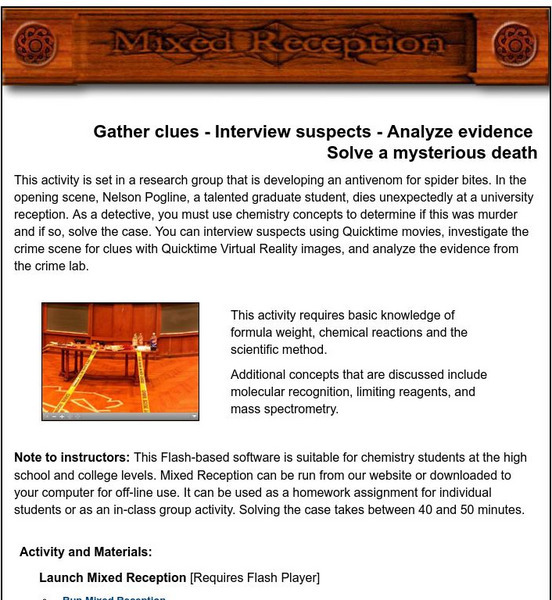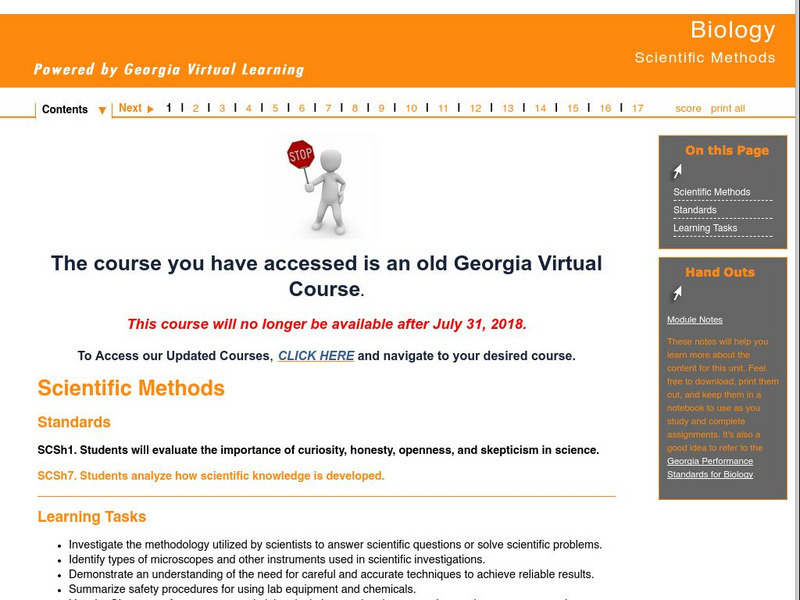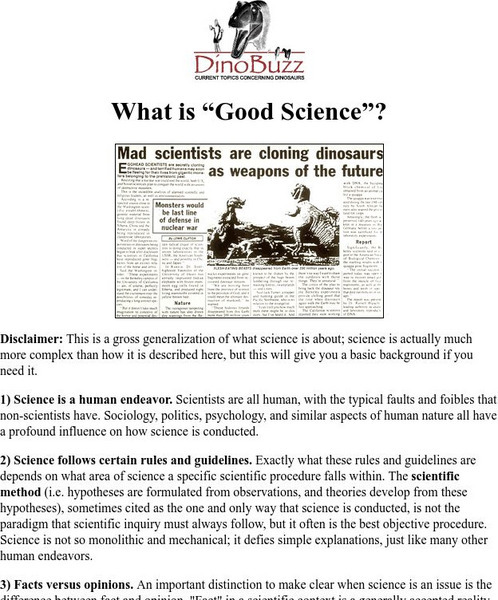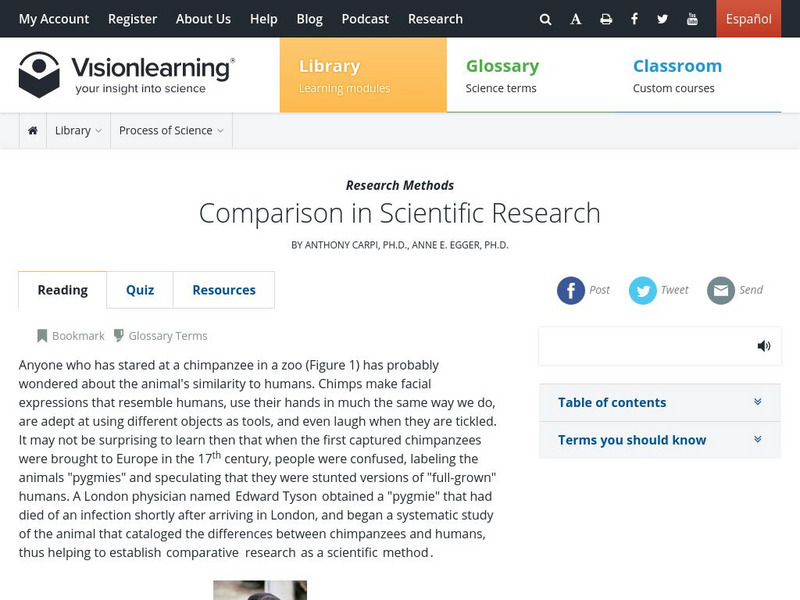Curated OER
Pulse
Students determine a baseline pulse rate then chart the changes in rate with exercise. They describe the changes and develop a rationale for their observations. The task assesses students' abilities to make simple observations, determine...
Curated OER
Measurement: Length, volume, and temperature
Learners determine the temperature of the water in a cup, measure the length of a piece of cardboard, and measure out an appropriate volume of water. This task assesses student's abilities to perform measurement and reporting skills.
Curated OER
Keep Cool
Students design an experiment to determine which type of container would be best to use to keep drinks cool on a hot day. Students test paper cups, styrofoam cups, and metal cans by filling them with ice water and they use a thermometer...
Curated OER
Variables
Learners watch a video show how to identify the independent variable, dependent variable and controls in an experiment; and design experiments that use controls to isolate a single independent variable and measure the resulting dependent...
Curated OER
Walk and Learn
Fourth graders take a nature walk on a nice sunny spring day. They discuss different things in nature. They write down observations in their notebook.
Curated OER
Integrating Critical Thinking Skills Into the Classroom
Students receive an overview of critical thinking techniques. They break into small groups and practice reasoning through questions, identifying, presenting and justifying their answers.
Curated OER
Thinking It Through: Discrepant Events
Students practice their skills of forming hypotheses by conducting various experiments.
Curated OER
Destructive Decay
Students determine the destructive nature of plaque acid in their mouths. They use the scientific method for proving a hypothesis.
Curated OER
Emulsion_ Compulsion
Students experiment with common household products to determine the properties of emulsions and how they fit into the classifications of matter through this series of lessons.
Curated OER
Exploring the Scientific Method: Separation of a Complex Mixture
Students work in teams to use the scientific method to separate complex mixtures into pure components.
Curated OER
Math and Science in a Wetland
Students use scientific methods during field and lab investigations. Students collect specimens and make measurements using the metric system. Students describe biotic and abiotic factors in an estuary and design a model.
Chemistry Collective
Chem Collective: Mixed Reception
Participate in the investigation of a virtual crime scene using chemistry concepts to solve a mysterious death. The 40-50 minute activity can be used as a classroom lab or as a homework assignment. Additionally, teachers may request a...
City University of New York
Scientific Method and Probability: Interactive Activity
This interactive lesson begins with the basics and carries through to methods of data analysis, all interactively. Supporting material is excellent.
Exploratorium
Exploratorium: From Jungle to Lab: The Study of Life's Complexity
An exhibit on what field biologists do. Hear from scientists who have worked in Belize about the reasons that they chose their career paths, the ideas that drive them in their research, the investigative tools they use, and about the...
Georgia Department of Education
Ga Virtual Learning: Biology: Scientific Methods
Through informational text, colorful animations, and video clips, students investigate the methodology utilized by scientists to answer scientific questions or solve scientific problems.
University of California
Ucmp: What Is "Good Science"?
A very good explanation of the scientific process and the differences between science and non-science. This is a concise and clearly written description.
Hunkins Experiments
Hunkin's Experiments
This amazing website provides access to 200 exciting experiments from cartoonist, broadcaster, and engineer, Tim Hunkin. Each experiment is categorized and illustrated.
Rice University
Rice University: Web Adventures: Medmyst: Nemesis in Neuropolis
In this online learning adventure game, students will play the role of scientist, historian, and detective. By solving the problem presented in this smallpox case, they will learn how infectious diseases are spread, how the smallpox...
University of Washington
Genome Sciences Education Outreach: Genetics of Taste (High School Level) [Pdf]
Multi-activity lesson plan in which students will use the scientific method to examine human variation in the ability to taste different substances.
Science and Mathematics Initiative for Learning Enhancement (SMILE)
Smile: Three States of Matter
Teachers can find an interactive lesson plan for introducing the three states of matter to the early elementary student using items that they are familiar with. This also includes gathering data and filling in a table, an important part...
Science Education Resource Center at Carleton College
Serc: Paper Helicopters: Variables and Experimental Design
Introduce scientific design and variables through this simple lesson of building paper helicopters. Activity includes a link to a video on how to make helicopters.
Science Education Resource Center at Carleton College
Serc: Ji Tt: Scientific Method
Students learn about the scientific method by planning an experiment to test a hypothesis. Their hypothesis should be based on a common pseudo-science or alternative health treatment topic. Students will compare their designs with other...
Vision Learning
Visionlearning: Research Methods: Description in Scientific Research
Specific examples are used show the importance of good description in scientific research since data and numbers are not always available.
Vision Learning
Visionlearning: Research Methods: Comparison in Scientific Research
Pros and cons of the comparative method of research are described. Specific examples are used to show how and why the comparative method may be used when researching.


















![Genome Sciences Education Outreach: Genetics of Taste (High School Level) [Pdf] Lesson Plan Genome Sciences Education Outreach: Genetics of Taste (High School Level) [Pdf] Lesson Plan](https://static.lp.lexp.cloud/images/attachment_defaults/resource/large/FPO-knovation.png)




